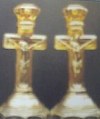Carnival Glass 101 | home Quick Reference to Carnival Glass Patterns on This Site
Snap Judgement
SNAP JUDGEMENT
(regarding Orange Tree Mugs)
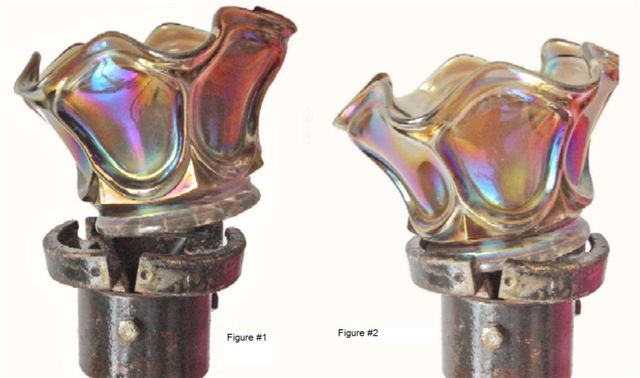
SNAP JUDGEMENT! (Snap-Shots!)
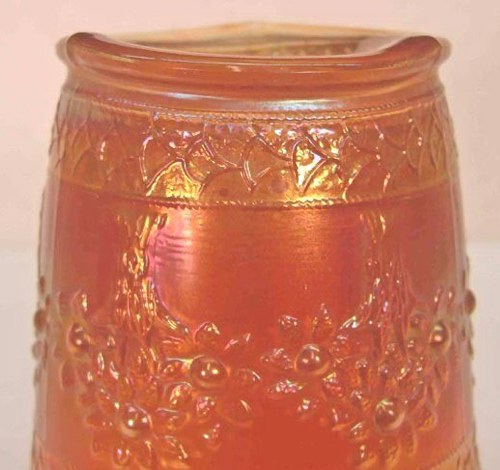
Marigold ORANGE TREE Mug - Courtesy Mike Carwile.
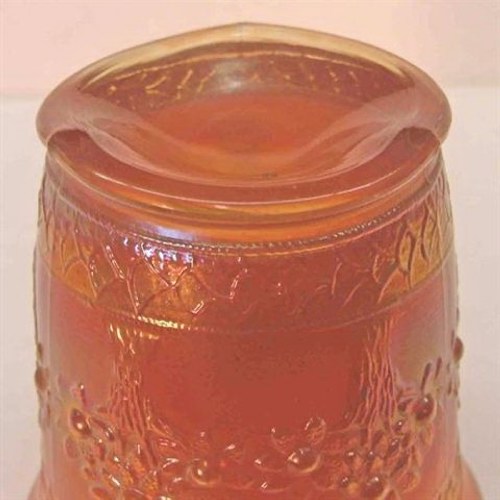
Marigold ORANGE TREE MUG - Courtesy Mike Carwile.
Not long after we initiated the San Diego Carnival Glass Club in 1985, the late Frank M. gave me (Dean), this snap and a glass mould. From time to time over the years since, a question arises such as the latest from Mike Carwile as to the origin of the disfigured base on an Orange Tree mug he found in March 2014. We hope our photos and discussion will help with understanding.
Since we had no mug with a 3” base, it was necessary to substitute the squat 4” high Parlor Panels vase in smoke to accommodate the snap.
FIGURE #1: Shows how the two pieces go together. The snap is in the open position and ready to receive the glass in a seated position on the snap, so the runner can take it to the glory hole and remove all of the sharp edges with heat. Shown is a three-part snap. It appears to be the same one used to create the mug presented by Mr. Carwile.
FIGURE #2: The pressman removes the glass shape from the press and places the glass into the runner’s snap with a metal fork. If the runner is in a hurry and closes the snap early, before the glass collar or marie is seated squarely into the snap; as shown in Figure #2, the snap closes with a spring loaded force, causing the hot glass to deform on two sides while one third of the collar-or marie is in the proper place. (See the two Marigold Orange Tree mug photos displaying disfigured bases, provided by Mike Carwile.)
The reason it continues through the manufacturing process: no-one wanted to lose a ½ cent per piece at that time in history. This explains the reason the inspectors did not toss it into the cullet bin.
Since we grew up in Parkersburg, WV, and visited relatives who lived at the end of the street which housed Fenton Art Glass Co., along with having Mr. Myers, head glass blower at the factory living next door to our relatives, I feel that we have an “inside approach” which few collectors can relate to.
The era prior to WWII (1938-1939), poses memories of having played on the factory dump before a fence was erected to prevent such!
From time to time, carefully sorting through the pile of discards, I (Diane) would “find” such a piece of glass as the mug in question! There usually were “some items worthy of salvaging!” If I was attracted to such pieces, can you not imagine that the man who set that mug into the snap in “off-position” would not decide to take that mug home to his son—or daughter? From there, such a mug would find its way into the market place in ensuing years? Each trip to the Fenton Gift Shop in years which followed, there were “seconds” for sale. (Items which were flawed in the making.)
If this mug was attractive/curiously interesting enough for Mike to purchase after these many years, how many others have found pleasure in owning it in the interim??
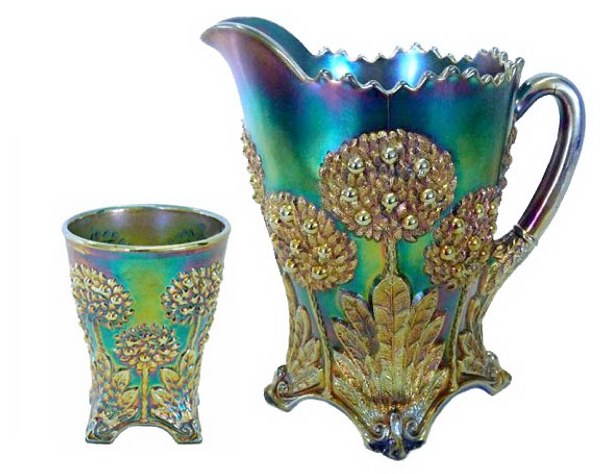
Blue (footed) ORANGE TREE without scales. Seeck Auctions.
The “family” of ORANGE TREE patterns has assumed a variety of names such as Small Orange Tree, Footed Small Orange Tree, along with Fenton Flowers. However, they should be considered under the same “family” name, which most collectors refer to as ORANGE TREE. Beginning in about 1911, with vast popularity, the pattern continued in production through the Depression Era well into the 1930s.
In addition to the water set, a hatpin holder, covered powder jar, and a 4 pc. table set, complete this “four-footed design”.
Water sets are known in blue and marigold. Pitchers: blue, ice green, lime green, marigold and white. One lime green opal pitcher has no top band.
Variant tumblers do not have the scale band connecting top orange trees.
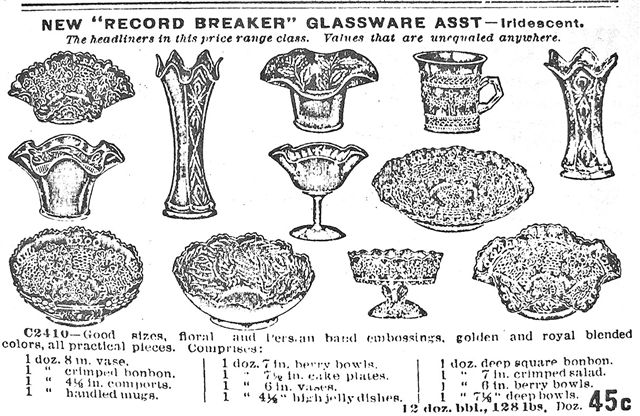
April 1913 Butler Brothers Wholesale Catalog.
Although the ORANGE TREE pattern was being produced in the form of a hatpin holder and powder jar as early as 1911, the first Butler Bros. ad displaying a handled mug did not appear until 1913. As you view some of the photos, you will notice the mould wear over progression of years. It would be interesting to know how many times over the course of more than twenty years, the moulds were replaced? Extensive wear is visible on many mugs.
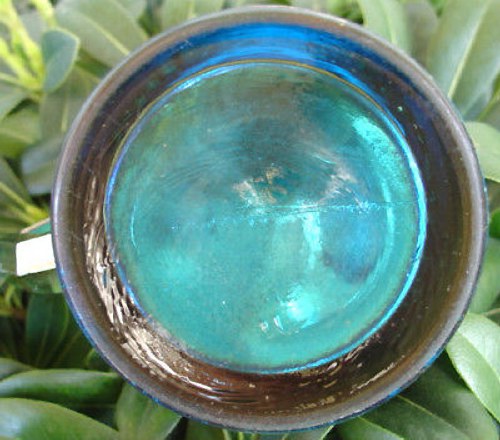
CELESTE Blue ORANGE TREE Mug.
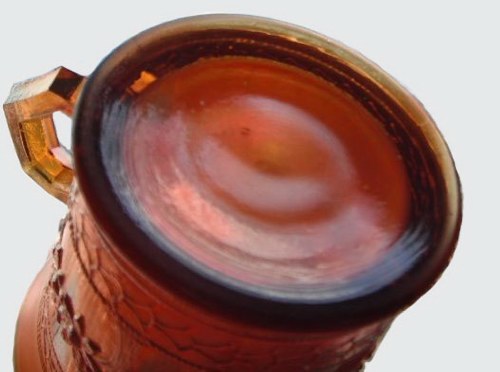
Amberina ORANGE TREE Mug.
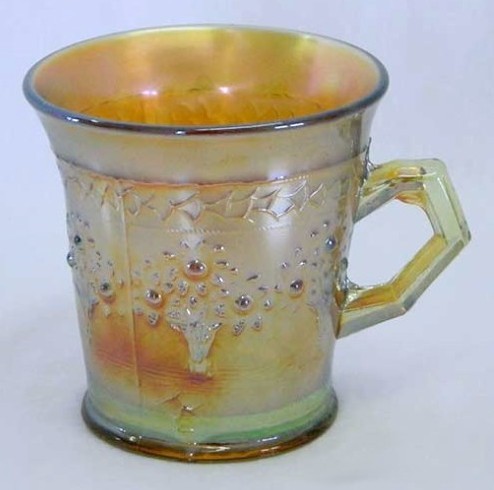
Lime Green with Marigold overlay -
ORANGE TREE Mug. - NOTE - Mould wear
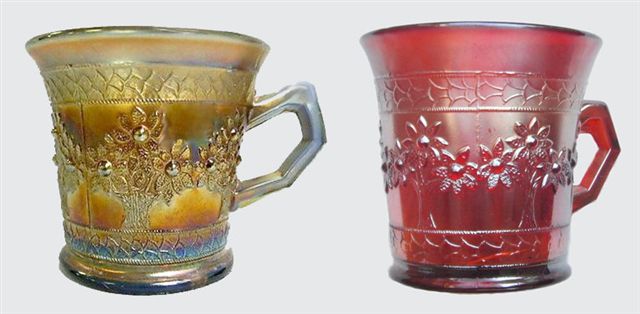
Amethyst and Red ORANGE TREE Mugs.
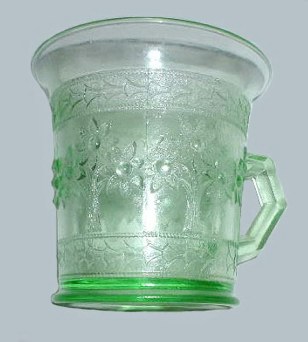
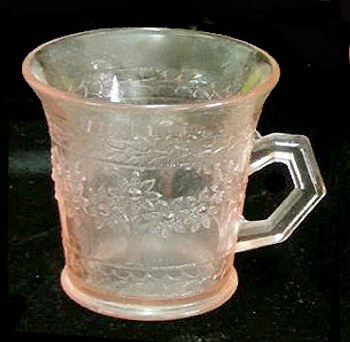
Depression pink and green mugs.
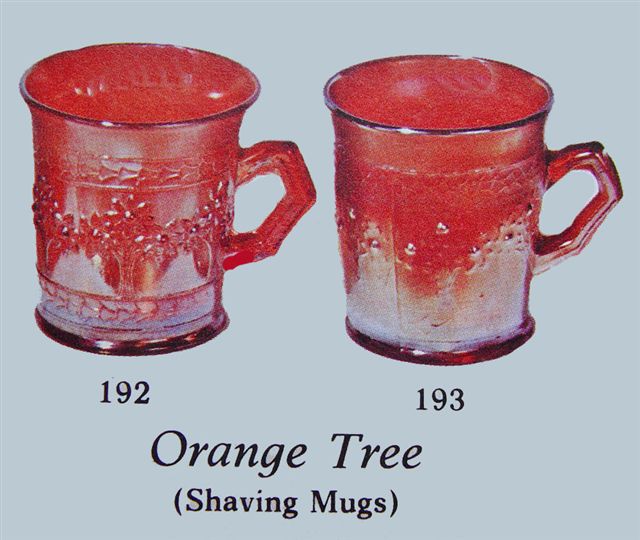
Pg. 47- FENTON - The First Twenty-Five Years.
FIGURES 192-193: #1430. ORANGE TREE shaving mugs, with the one on the right made from an old worn mold; mug made in two sizes: SHAVING mug has 3” base. STANDARD mug has 2 ½” base. Ad seen in Fenton Glass-The First Twenty-five Years.
SHAVING Mugs: 3” Base
Amber
Amberina
Amethyst
Aqua
Aqua Opal
Blue
Blue, Powder
Green
Lavender
Lime Green
Marigold
Red
Red, Mandarin
Red, Mandarin, Slag
Red Slag
Vaseline
|
STANDARD Mugs: 2 ½” Base
Amber
Amberina
Amethyst
Aqua - Teal
Aqua Opal
Blue
Blue, Powder
Celeste Blue
Depression Rose Pink
Green
Lavender
Lime Green
Marigold
Red
Red, Mandarin
Red, Mandarin, Slag
Red Slag
Vaseline
White
Depression Translucent Emerald Green
|
Dean & Diane Fry, March 2014
As it is written:
“There is none righteous, no, not one; there is none who understands; there is none who seeks after God.
They have all turned aside; they have together become unprofitable; there is none who does good, no. not one.”
“Their throat is an open tomb; with their tongues they have practiced deceit”;
“the poison of asps is under their lips”; “whose mouth is full of cursing and bitterness.”
“Their feet are swift to shed blood; destruction and misery are in their ways;
and the way of peace they have not known.”
“There is no fear of God before their eyes.”
(Romans 3:10-18)
(Paul’s letter to the Romans begins by describing the sorry state of the human condition.
Because of sin, we are separated from the God who created and loves us.)
Should you care to contact the Frys, their email address is:
Search Carnival Glass 101
back to Carnival Glass 101
Our other sites you may enjoy:
Everything you EVER wanted to know about Indiana Glass
Great Reference for Newer Carnival Glass.
Complete Glassware Catalogs Available to Download
Questions? Comments? Suggestions? Broken Links? Corrections?
Your Friendly Webmaster is here to help!
